
When it comes to getting the best price for the jewelry you no longer wear or want, it’s a case of seller beware.
With the high valuation of gold these days, the incentive to sell jewelry can be pretty strong. People are holding wine-and-cheese “gold parties” where they sell their jewelry for scrap value. Buyers are everywhere, proclaiming “We buy gold! Highest prices paid! Gold at record highs!”
This is not entirely true. Although the $1,000-an-ounce mark does have an unfamiliar ring to it, the benchmark is deceiving. Gold would have to hit $2,200 an ounce in today’s dollars to match the 1980’s high of $850. Silver was also at its high in 1980, bubbling from $8 an ounce in the fall of 1979 to over $49 in 1980. As a result, people sold anything and everything for scrap weight. Too many put too little thought to the importance of a piece itself, scrapping everything thing from exquisite examples of Georgian gold jewelry to Tiffany & Company exhibition silver – work with artistic or historic value -and therefore financial value – far in excess of its weight.
Don’t get us wrong – if you have kinked out chains or big hollow necklaces last seen on the Carringtons in Dynasty, it’s a perfectly good idea to scrap them. Just don’t make the mistake of cleaning out your jewelry box or silver drawer before you run the contents past an expert.
Here’s what we know that you may not:
• Not all gold is marked. The American stamp act didn’t occur until 1906. Prior to that, much wasn’t marked at all.
• The U.S. system that equates 24k gold with absolute pure gold is not and has never been a universal system. Most European countries and their colonies use a system wherein 1000 gold is absolute pure, 750 equates to 18k and 585 equates to 14k. These numbers are often confused for other marks.
• The UK had a strong assay office that demanded gold and silver be marked clearly and uniformly. Not so with most other countries. Foreign marks – if pieces were marked at all – are often obscure and hard to find. You may not even see them.
• Russian and French jewelry are highly valued and proper identification can greatly affect appraisals, but this can be difficult. French brooches tend to be marked on the pin stem. If the pin has been replaced, as frequently happens, the marks are gone. Russian assays are yet a different calculation (measured in zolotniks) and Russian marks are both easily confused and often “enhanced” by shady operators.
• Late 19th century flatware services were produced with as many as a hundred different specialized utensils. Some of these place and serving pieces are rare, eagerly sought after by buyers looking to accumulate complete antique sets.
• Early American silver marks intentionally resembled the English marks. Values of American Federal silver far exceed those of imported pieces of the same era.
• Even broken pieces can have greater than scrap value. You might be surprised to know, too, that fine gems have not always been set in noble metal. Prior to the 20th century, diamonds were set into silver as a matter of course. These old cuts of diamonds may look like roughly faceted pieces of glass or rhinestones. Rago’s jewelry specialist Sarah Churgin has often identified antique silver jewelry as set with old diamonds, much to the surprise and delight of the owners.

Rarity and importance of maker is a factor that must be considered. A piece of jewelry made by the Kalo Shop will look deceptively simple to most and may resemble the work of many other makers of the Arts and Crafts era (1880 – 1910). No matter. Kalo Shop has great value despite (or because) of its simplicity and much greater value than similar pieces of the era, particularly in gold.
Provenance and inscription can likewise elevate value. Rago’s sold an historic commemorative tea caddy made of American coin silver for $2,880. The value of the silver itself? Only $200. Here are a few more examples of prices realized at Rago’s last December with the prices this jewelry and silver would fetch as scrap as of this writing:
• Lot 1001: Enameled 14k yellow gold fly brooch by A.J. Hedges, Newark, 1890-1900. Scrap value:
$300. Sold for $5,100.
• Lot 1168: Ed Wiener 18k yellow gold cuff. Scrap value: $950. Sold for $7,200.
• Lot 1269: Mexican silver cuff by William Spratling, ca. 1940. Scrap value: $30. Sold for $1,440.
• Lot 1603: Tiffany & Co. exhibition grade silver vase, ca. 1901. Scrap value: $1500. Sold for
$57,000.
• Lot 1608: GORHAM MARTELE silver open sugar bowl, 1906. Scrap value: $200. Sold for $1,920.
– – – – – – – –

Don’t miss the Rago Arts Jewelry Auction on December 6, 2009. Exciting pieces are rolling in, and jewelry specialist Sarah Churgin is glad to share this special brooch with Gem Gossip readers.
The Details: Walt Disney’s “Dance of The Hours” platinum and diamond lapel-pin watch by Cartier. Starting in1934 and continuing through the 40’s Cartier produced commissioned gems for Disney based on characters from cartoon and animated features. In Disney’s “Fantasia”, 1940, Ponchielli’s ballet “Dance of the Hours” is performed to comic effect by some graceful and some not so graceful animals, including a troop of elephants. The pun is captivating in that this gem is a timepiece! The rectangular watch, twice signed by Cartier, hanging from a lapel pin in the form of an elephant’s tusk, suspends two dancing elephants. Diamond pave’ throughout, ruby eyes. Movement: 17 jewels by J. Schulz, Swiss, c. 1940.
>>Interested in owning this rare Cartier brooch? Then register and bid–for more information check out Rago Arts’ website. To read Gem Gossip’s exclusive interview with jewelry specialist Sarah Churgin, click here.

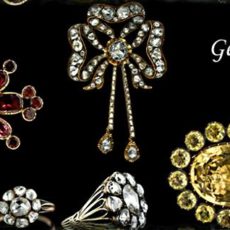
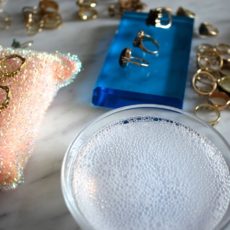
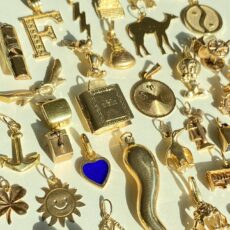
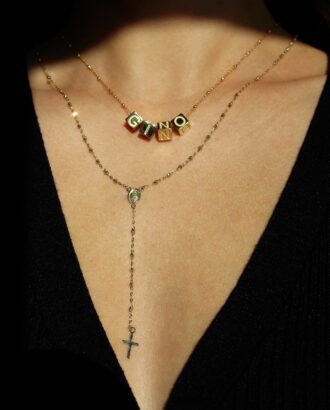
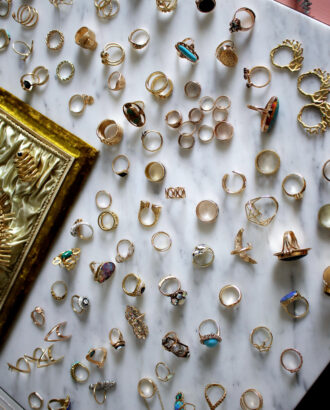
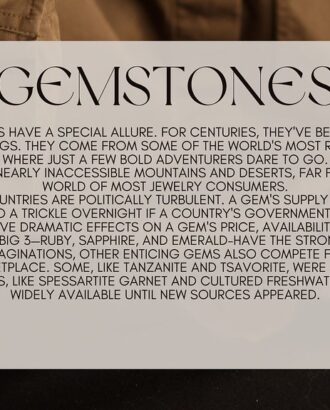
lulu November 7, 2009 at 5:52 pm:
Very intresting article. Scraping should be a last resort unless the piece is horribly unwearable. I recently scrapped a pair of sizable 14k earrings and learned the hard way. Now that I know, jewelry is priced by the design value too, I will avoid scrapping. Thank you.
gemgossip November 8, 2009 at 1:52 am:
Glad you enjoyed the article. It is written by Sarah Churgin, who knows her stuff! I thought it would be vital to share–especially now.